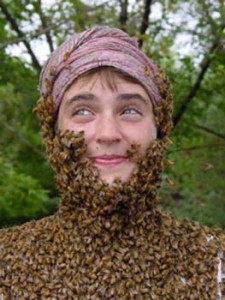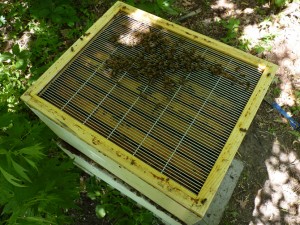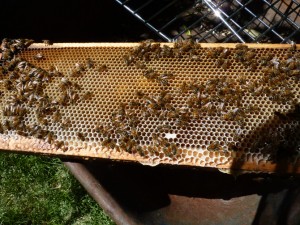Summer Waning Strawberry Moon
Dave Schroeder, president of the Minnesota Hobby Beekeepers, came by this morning to look at my bees. We opened up the package colony first. “They’re drawing out comb, look good.” He gave me a tip about keeping  3/8″ inch between foundations–bee space. “If they have more space than than, they’ll fill it with comb. Wasting their time.” “You moved a frame up from below. Good. Just like you’re supposed to do.”
3/8″ inch between foundations–bee space. “If they have more space than than, they’ll fill it with comb. Wasting their time.” “You moved a frame up from below. Good. Just like you’re supposed to do.”
(a fellow docent’s daughter, Megan. she was a graduate student in the bee department at the time.)
We cracked the parent colony. Taking the telescoping cover off he placed it bottom side up. “That’s where I put the supers,” he said, “Helps you avoid killing bees.”
As I lifted the top two off, he asked, “Any weight to’em?”
“Nope.”
He checked them. I then took the fullest honey super off. It weighs about 50 pounds. Heavy, man. And the next one. A bit more weight on that one than last Friday.
We checked the colony itself, in this case I wanted him to take a look, give me his impression. “That on top is drone comb. That means you’ve got a happy colony. Now, I always scrape this off.” He took his hive tool, scraped along the top of the frame, lifted off the drone cells with their white larvae exposed and dumped them in front of the hive. “It’s just neater.”
He made sure each box was square and fit perfectly on the next one. I like to do that, too, but the heat or the weight of the box sometimes makes it hard for me. I’m a little guy.
After that, we replaced the queen excluder, the honey supers and moved  over to the divide. Oh, he did tell me I had the queen excluder on upside down. Ooops.
over to the divide. Oh, he did tell me I had the queen excluder on upside down. Ooops.
Commercial beekeepers apparently refer to queen excluders as honey excluders. The bees don’t like to climb through’em, so it slows down honey production.
On the divide, the one that prompted me to connect with him, we removed the two honey supers I’d put on as he suggested. Then we looked at the top hive box which had honey on almost all of its frames. There he showed me about moving end frames into the middle of the box. “The bees won’t draw out comb on the side facing the box. This way they will.”
“Yeah. This is plugged with honey. If you don’t put supers on, they’ll crawl up here (into the third hive box), think, well, we’re done. Ready for winter. Then they won’t go up into the supers.” I’m not clear why putting the honey supers on solves this problem.
He suggested I take the queen excluder off this one for a week. That will encourage the bees to go up. “Bees like to go up.” Takes one barrier away.
After we closed this colony, he said, “Where did I shake out those bees?” Dave had shaken bees off the queen excluder as we checked it in the parent colony. “Oh, yeah. Let me show you another trick.” He searched around, found a stick a bit thicker than a thumb and round. Breaking it off at about 8 inches, he put it in the middle of the bees on the ground and rested the other end against the hive entrance. “They’ll climb up that and get back in the colony a lot faster.”
As we finished, he said he likes to have all his colonies facing south and in the open. “That way, they come to the entrance, look out, go, Oh, it’s sunny! Think I’ll go out and go to work.”
A lot of the comments he made were straight forward tips gained from years in bee-yards. He’s been at it since 1974, 46 years by my count.
(Got this on 7/8 from Bill Schmidt. Why I’m not a scientist. By the way, your math on the beekeepers years with bees needs attention. 2010 – 1974 = 36 years, not 46.)
After we finished the hive inspections, “Your bees are doing good.” we sat in front of the honey house and talked bees for about a half an hour.
He keeps about 100 colonies and plans to take them to California this fall. “Out there they can work. Get strong. Here, they’re just struggling to survive.”
He told about honey extracting, the relative merits of different kinds of equipment, about the high trailer he uses to store honey supers near his colonies, the years he spent working for his brother-in-law, “I wouldn’t take no money. I was just in it for the education.”
He says 100 doesn’t make him commercial. When I asked him what does make a commercial bee-keeper, he said, “Oh, 400-500 colonies at least.”
It was a pleasure to have him over and very useful.

 3/8″ inch between foundations–bee space. “If they have more space than than, they’ll fill it with comb. Wasting their time.” “You moved a frame up from below. Good. Just like you’re supposed to do.”
3/8″ inch between foundations–bee space. “If they have more space than than, they’ll fill it with comb. Wasting their time.” “You moved a frame up from below. Good. Just like you’re supposed to do.” over to the divide. Oh, he did tell me I had the queen excluder on upside down. Ooops.
over to the divide. Oh, he did tell me I had the queen excluder on upside down. Ooops.